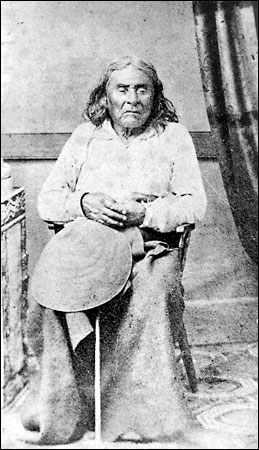Chief Seattle
|
|
Chief Seattle or Sealth of the Suquamish and Duwamish Native American tribes, was born around 1786 on Blake Island in Washington state, and died June 7, 1866 on the Suquamish Reservation at Port Madison (now Bainbridge Island, Washington). His father, Schweabe, was a noble of the Suquamish tribe, and his mother was Scholitza of the Duwamish. Seattle, Washington was named after him.
Seattle earned his reputation at a young age as a leader and a warrior, ambushing and defeating groups of enemy raiders coming up the Green River from the Cascade foothills, and attacking the S'Klallam, a powerful tribe living on the north shore of the Olympic Peninsula. He also married well, taking wives from the village of Tola'ltu just southeast of Duwamish Head on Elliott Bay (now part of West Seattle). His first wife died after bearing a daughter. A second wife bore him sons and daughters. After the death of one of his sons, he sought and received baptism in the Roman Catholic Church, probably in 1848 near Olympia, Washington. His children were also baptized and raised in the faith, and his conversion marked his emergence as a leader seeking cooperation with incoming American settlers.[1] (http://content.lib.washington.edu/aipnw/buerge2.html)
In an American Indian Quarterly paper assessing Seattle's legacy, Klallam leader Phillip Howell is said to have thought of him as "a low type of Indian, a joke among the Natives and worse, a coward and a traitor" for going along with the treaty negotiations and yielding Indian lands to the white men. A different view is cited by Peg Deam, a cultural development specialist at the Suquamish Tribal Council. She is quoted as saying Chief Seattle "was put in a position where he had to make some very difficult--and ultimately harmful--choices. Many hearts were broken because their lifestyle was completely changed. The settlers made the Natives move to these little pieces of land, separated from each other. But as a leader and what he could foresee at that time, I think he made the right choice." [2] (http://seattlepi.nwsource.com/getaways/57273_heritage07.shtml)
Murray Morgan remarks in Skid Road that a Puget Sound-area chief was merely "a rich man with some eloquence, a man whose opinions carried more weight than those of his fellow tribesmen," rather than a hereditary leader. He also points out that Chief Seattle was exceptional in that he first made his mark as a warrior, but served primarily as a peacetime tyee.
Chief Seattle's grave marker reads "Seattle, Chief of the Suquamps and Allied Tribes, Died June 7, 1866. Firm Friend of the Whites, and For Him the City of Seattle was Named by Its Founders," and, on the reverse, "Baptismal Name: Noah Sealth, Age probably 80 years."
(The sacramental register of those who likely baptised Seattle, the Oblates of Mary Immaculate at the St. Joseph of Newmarket Mission near Olympia, gives his name as Noe Siattle.)
| Contents |
"Chief Seattle's Reply"
A speech given by Chief Seattle in January 1854 was reported by Dr. Henry A. Smith in the Seattle Sunday Star newspaper in 1887. It is most usually called Seattle's Reply since it was a response to a speech by Territorial Governor Isaac M. Stevens. While there is no question that Chief Seattle gave a speech on this occasion, the accuracy of Smith's account is highly subject to question [3] (http://www.archives.gov/publications/prologue/spring_1985_chief_seattle.html), let alone the accuracy of later accounts that derive from Smith's.
While Smith is known to have been present on the occasion of the speech, he did not speak Chief Seattle's native coastal Salish, and there is some question as to how much of a translation even into Chinook jargon was done at the time. According to the National Archives and Records Administration, "The absence of any contemporary evidence...create[s] grave doubts about the accuracy of the reminiscences of Dr. Smith in 1887, some thirty-two years after the alleged episode. Thus it is impossible...to either confirm or deny the validity of this...message." Certainly the rhetorical flourishes in Smith's version are his own, not Chief Seattle's.
While the content of the speech is in question, contemporary witnesses all agree that it was about half an hour in length, and that throughout the speech Chief Seattle, a rather tall man, had one hand on the head of the rather diminutive Governor Stevens.
A second version of the speech was edited into more modern language by William Arrowsmith in the 1960s.
The speech became famous again when a third version of it began to circulate in the 1980s. The newest version appears to bear little resemblance to the old, and is widely believed to be the work of Ted Perry, an East Coast scriptwriter, for a 1972 ABC film about ecology called Home. This version casts Chief Seattle as an early ecological visionary, speaking of the insights of his people into the workings of nature, and caused him to be cited as a role model of the environmental movement (rightfully or not).
A shortened version of the third version is also circulating.
See also
External links
- Chief Seattle and Chief Joseph: From Indians to Icons. (http://content.lib.washington.edu/aipnw/buerge2.html)
- A version of Chief Seattle's speech. (http://www.halcyon.com/arborhts/chiefsea.html)
- About the four versions (http://www.synaptic.bc.ca/ejournal/wslibrry.htm) and About Chief Seattle. (http://www.synaptic.bc.ca/ejournal/seattle2.htm)
- Biographical page on Chief Seattle. (http://www.chiefseattle.com/history/chiefseattle/chief.htm)
References
- Skid Road, Murray Morgan, 1951, 1960, and other reprints, ISBN 0295958464de:Seattle (Häuptling)

